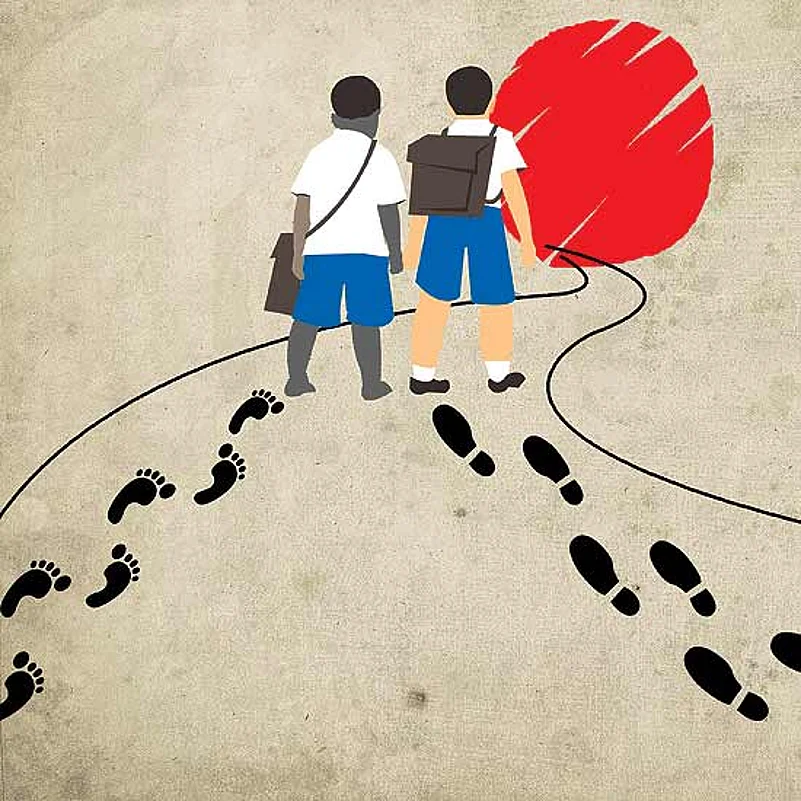Amongst the many academic views on the Right To Education debate, I write this column from a completely different perspective—as a mother whose 5-year-old is part of the first cohort in which Delhi schools admitted students from economically weaker sections, or EWS as the acronym goes. It is a contraction that functions as the most discriminatory tool of all—the three alphabets are virtual scarlet letters, branding children when the focus must be on integrating them. The truth is, if implemented properly, classrooms in which the RTE experiment are being carried out will shape India’s next social revolution.
Already, the changes are significant ones. All of us have heard the stories of parents who don’t have the time to stand in long admission queues at top Delhi schools and send their drivers instead. Now, the drivers stand in line to admit their own children. Children share their tiffins, form playground friendships and engage in battles indiscriminately—albeit with the complete fickleness common to five-year-olds. Too young to be shaped by their parents’ prejudices, their choices of friends are made straight from the heart. At school functions, the PLU demographic has a completely different landscape: people like ‘us’ now include people like ‘them’, and grappling with that fact is the adult’s problem, not the child’s.
It also throws up a completely different set of challenges. I was chatting with a young father at our school gates who works as an office peon. His monthly salary is about the same as the pocket money of some of the children in his son’s class. His dilemma seemed a small one—his child had come home with a birthday party invitation (the school enforces a strict policy that no child is left out of birthday party invites circulated in class), but represented a much larger issue. The father’s quandary: they didn’t have a maid to send the child with. So would the parents be an embarrassment if they went too? Would they be able to mingle with the other parents or be consigned to the area of the domestic staff? Wouldn’t it be easier if his son just didn’t go? And yet, the party was all the little boy could talk about.
Eventually, his solution was “Madam decide karegi”, the class teacher, an indication of how important a role the teachers and the school have to take on in this transition... whether it’s helping with English homework, making sure that the starring role in a school play isn’t bagged only by kids from the same background, or even a firm ‘No’ to parents who don’t want their kids to be in a class with too many of ‘those children’. For schools, it’s not just about educating children, the real challenge is educating parents.
Yet, the onus cannot only be on private schools, the point about the government abdicating responsibility is a valid one. Given the thousands of crores that are poured into the government school system, why are private schools the holy grail for any parent who harbours aspirations for his or her child? In eastern Uttar Pradesh, I have seen parents who earn a few thousand rupees a month pay almost half that to get their child a so-called English education in ridiculously named schools like ‘The King’s Convent’. They won’t send their child to free government schools. Instead, they will take loans to meet the private school’s fees because they feel getting them an English education is the child’s ticket to a better life. Yet, we will have politicians and bureaucrats who, while insisting that government schools must be Hindi medium or in the local language, will send their own children to English medium schools. In India today, English is seen as the language of the elite and until this is given prominence in government schools as well, the craze for private schooling won’t end.
Another contradiction is that in India, we now have two different parameters being used to calculate reservation in education. In primary education, it is economic background or class; in higher education, it is caste. If the right to education act can be implemented in full at the primary level, shouldn’t we then consider whether in higher education, caste-based reservations can be abolished—adopting the US model of affirmative action instead? Make the classrooms of our future doctors, engineers and management graduates more inclusive through reservation for poor students from different backgrounds, but without any compromising on merit.
In the final analysis, as the Supreme Court said, the debate is not about private or government schools, but about the child. Our children are India’s future, let them grow up in a country where equality begins in their classrooms.
(The writer is editorial director, NDTVv, and 24x7 mother of 3)
















